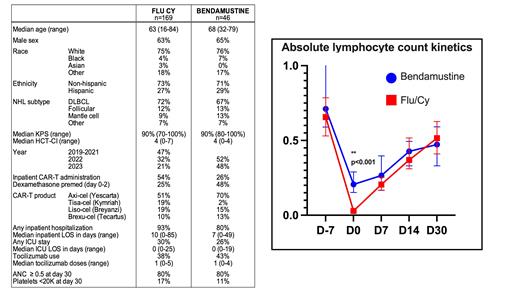Background
As CAR-T treatment volumes and approved indications rapidly expand, identifying optimal lymphodepleting chemotherapy (LDC) regimens is an urgent and unmet need. A combination of fludarabine and cyclophosphamide (flu/cy) is most commonly performed. However, an ongoing international fludarabine shortage1 has led to the use of bendamustine (benda), a potent lymphotoxin, as LDC, with initial reports suggesting similar efficacy with less toxicity2, 3. We performed a multi-center retrospective analysis of patients with non-Hodgkin lymphoma (NHL) who have received benda or flu/Cy LDC prior to infusion of FDA-approved CAR-T products across the Sarah Cannon Transplant and Cellular Therapy Network (SCTCTN). We hypothesized that, compared with flu/cy, benda is noninferior in terms of lymphodepletion, hematologic recovery, CAR-T response and toxicities, as well as resource utilization.
Methods
We retrospectively analyzed 215 NHL patients receiving benda (46) or flu/cy (169) LDC prior to commercial CAR-T from 2018-2023 in the SCTCTN CAR-T registry. Patients on clinical trials, who received CAR-T for other malignancies than NHL, or were within 30 days of CAR-T infusion were excluded. Absolute lymphocyte count (ALC), neutrophil, and platelet kinetics were measured. Cytokine release syndrome (CRS) and immune effector cell associated neurotoxicity syndrome (ICANS) were graded according to consensus criteria of the American Society of Transplant and Cellular Therapy (ASTCT), and the occurrence, maximum grade, days to onset/resolution, and tocilizumab dosing were recorded.
Overall survival (OS), progression free survival (PFS), and resource utilization (length of stay in hospital and ICU requirement) were recorded.
Results
Characteristics of patients receiving benda and flu/cy were matched in terms of age, gender, race, ethnicity, NHL subtype, performance status. Flu/cy and benda produced deep absolute lymphocyte count (ALC) nadirs by the date of CAR-T infusion (day 0) with subsequent partial recovery by day 30. Lymphodepletion nadir at day 0 was deeper [P<0.001] with flu/cy (ALC 0.03 K/uL, IQR range 0.01-0.05) than benda (ALC 0.21 K/uL, IQR range 0.1-0.3) but not at other time points. The kinetics of neutrophil and platelet recovery were similar between groups suggesting an equivalent extent of marrow suppression. Parameters of resource utilization such as inpatient hospitalization, length of stay, ICU utilization, and the use of tocilizumab were similar between flu/cy and benda recipients.
Conclusion
In a large cohort of real-world CAR-T recipients, benda produced efficient lymphodepletion and equivalent outcomes compared to traditional flu/cy. While flu/cy produces a deeper nadir than benda at day 0, this difference did not exert clinical relevance.
Disclosures
Rao:Janssen: Honoraria. Flinn:TG Therapeutics: Consultancy; Myeloid Therapeutics: Consultancy; Vincerx Pharma: Consultancy; Innocare Pharma: Consultancy; Kite: Consultancy; Novartis: Consultancy; Secura Bio: Consultancy; Servier Pharma: Consultancy; Hutchinson MediPharma: Consultancy; Genmab: Consultancy; Genentech: Consultancy; Century Therapeutics: Consultancy; BeiGene: Consultancy; AbbVie: Consultancy. Pantin:Omeros, Sanofi: Speakers Bureau; Orca Bio: Research Funding; Omeros: Honoraria. Shaughnessy:Sanofi: Speakers Bureau; BMS: Speakers Bureau. Battiwalla:Novartis: Research Funding; Fate Therapeutics: Research Funding.


This feature is available to Subscribers Only
Sign In or Create an Account Close Modal